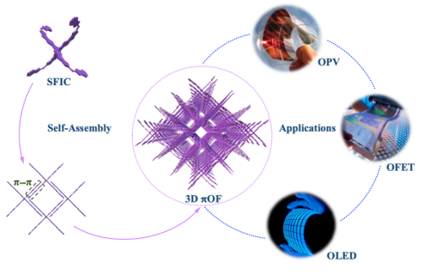Graphical Abstract

Abstract
Organic electronics is an emerging field of research with interdisciplinary approaches. The primary aims of the current organic electronics research are centred around combating the obstacles faced by existing silicon-based semiconductors in microelectronics, resolving the energy crisis, and realizing flexible and wearable micro-detection device. Currently, tremendous progress has been made in the field of organic optoelectronics. The performance of these materials, however, are still inferior to their inorganic counterparts, thus limiting their practical applications.
We are primarily involved in research works pertaining to π-conjugated materials and their applications in photoelectric conversion. In the field of organic photovoltaics, aggregated structure is precisely adjusted, and the charge transmission performance is improved through modifications in the topological structure of the perylene diimide multichromophore, achieving the highest power conversion efficiency of perylene diimide-based nonfullerene acceptor material. In the field of perovskite photovoltaics, the short life and high cost of perovskite solar cells is addressed through the design of a spiro-ring system substituted by thiophene terminal groups. A series of cheap, stable and efficient small molecule charge transport materials have thus been successfully developed, achieving the record high power conversion efficiency and thermal stability for small molecule charge transport materials. We also seek to use the newly self-proposed concept of πOF (non-covalent π-Stacked Organic Framework) to create a novel multifunctional supramolecular organic porous crystal material system. Its application in organic electronics will also be explored to further new breakthroughs in the device performance and stability.
Keywords
Organic electronics; self-assembly; organic framework; self-assembly; porous materials.
References
- Meng, Dong; Wang, Rui; Lin, Janice B.; Yang, Jonathan Lee; Nuryyeva, Selbi; Lin, Yu-Che; Yuan, Shuai; Wang, Zhao-Kui; Zhang, Elizabeth; Xiao, Chengyi; Zhu, Danlei; Jiang, Lang; Zhao, Yepin; Li, Zhenxing; Zhu, Chenhui; Houk, Kendall N.; Yang, Yang; Chlorinated Spiroconjugated Fused Extended Aromatics for Multifunctional Organic Electronics, Advanced Materials, 2021, 33(12): 2006120.
- Meng, Dong; Yang, Jonathan Lee; Xiao, Chengyi; Wang, Rui; Xing, Xiaofei; Kocak, Olkan; Aydin, Gulsevim; Yavuz, Ilhan; Nuryyeva, Selbi; Zhang, Lei; Liu, Guogang; Li, Zhenxing; Yuan, Shuai; Wang, Zhao-Kui; Wei, Wei; Wang, Zhaohui; Houk, K. N.; Yang, Yang; Noncovalent π-stacked robust topological organic framework, Proceedings of the National Academy of Sciences of the United States of America, 2020, 117(34): 20397-20403.
- Meng, Dong; Liu, Guogang; Xiao, Chengyi; Shi, Yanjun; Zhang, Lei; Jiang, Lang; Baldridge, Kim K; Li, Yan; Siegel, Jay S; Wang, Zhaohui; Coran nurylene pentapetalae, Journal of the American Chemical Society, 2019, 141(13), 5402-5408.
- Meng, Dong; Fu, Huiting; Xiao, Chengyi; Meng, Xiangyi; Winands, Thorsten; Ma, Wei; Wei, Wei; Fan, Bingbing; Huo, Lijun; Doltsinis, Nikos L; Li, Yan; Sun, Yanming*; Wang, Zhaohui; Three-bladed rylene propellers with three-dimensional network assembly for organic electronics, Journal of the American Chemical Society, 2016, 138(32), 10184-10190.
- Meng, Dong; Sun, Dan; Zhong, Chengmei; Liu, Tao; Fan, Bingbing; Huo, Lijun; Li, Yan; Jiang, Wei; Choi, Hyosung; Kim, Taehyo; Kim, Jin Young; Sun, Yanming; Wang, Zhaohui*; Heeger, Alan J.; High-performance solution- processed non-fullerene organic solar cells based on selenophene-containing perylene bisimide acceptor, Journal of the American Chemical Society, 2016, 1 38(1), 375-380.
Biography
Dong Meng currently works a postdoctoral researcher in UCLA. Over the years, his research has resulted in many groundbreaking innovations and he currently has a h-index of 22 (google scholar). Dr. Meng is primarily involved in research works pertaining to π-conjugated materials and their applications in photoelectric conversion. To date, Dr. Meng has been awarded four patents in China and one in the US. He has published a total of 48 articles in high-impact journals including Science, J. Am. Chem. Soc., Proc. Natl. Acad. Sci. U S A., and Adv. Mater. Among these innovative works published thus far, Dr. Meng first authored and co-authored 11 publications with 5 of them published on J. Am. Chem. Soc., one on PNAS, two on Adv. Mater., and one on CCS Chemistry. The success of these works is apparent in the high number of citations – Dr. Meng’s publications have been cited over 3168 times, with the highest citation of 617 on a single publication. One of his works was even awarded “Top 100 Most Influential Academic Dissertations of the Year” in 2016. Furthermore, various works were highly recognized by domain experts and reported over the world. He also received a National Scholarship for Doctoral Students in 2016 and the Chinese Dean of Science Institute Award in 2017. More recently, Dr. Meng was also selected as the international Vebleo Fellow Jr and delivered a keynote talk.
Video Proceedings of Advanced Materials

Upcoming Congress



